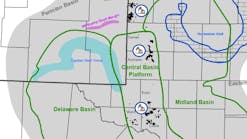The leaders of Chesapeake Energy Corp. plan to ramp up activity in Texas’ Eagle Ford basin in 2022 as part of an investment plan they expect will contribute to forecasted profit growth of more than 50%.
Oklahoma City-based Chesapeake last month reported third-quarter adjusted EBITDAX of $519 million, which was more than double its prior-year number. (Its net loss was $345 million, primarily due to the booking of $618 million in unrealized losses on oil and natural gas derivatives.) President and Chief Executive Officer Nick Dell'Osso and his team are forecasting full-year EBITDAX of more than $2.1 billion and, thanks to higher commodity prices, and expect that number to grow to $3.2-3.4 billion in 2022.
Production
Chesapeake averaged net production of 436,000 boe/d during the third quarter, with natural gas accounting for about 80%. The recently completed $1.3 billion acquisition of Vine Energy, which added three rigs and two completion crews in the Haynesville, will be a factor in that number growing to an estimated 575,000 and 595,000 boe/d in 2022. But so will higher production from Chesapeake’s assets in the lower Eagle Ford: On the roughly 220,000 net acres it is working there, Chesapeake plans to run one to two rigs and drill 40-50 wells in 2022. That’s up from about one rig and less than 20 wells drilled this year.
“You should think about those as being long-term programs that we feel really good about,” Dell’Osso told analysts and investors on his team’s quarterly conference call, pairing the Eagle Ford operations with Chesapeake’s key assets in the Haynesville and Marcellus (where it has three rigs).
Also helping output in the Eagle Ford are lower decline rates: Vice-President Tim Beard said Chesapeake’s field teams have pushed through a capital cleanout program “that's been very accretive to what we're doing there on the oil side.” Beard also noted that other efficiency and engineering programs are contributing to production."
Delineation
On their call last month, Dell’Osso and his team also said they are allocating about 15% of their $1.3-1.6 billion 2022 capital spending plan to what he called “further portfolio delineation.” That includes testing and wider spacing efforts in the Brazos Valley and Powder River regions, where Chesapeake plans to drill a combined 5-20 wells next year. Dell’Osso said he expects those moves will improve the company’s returns and give his team a better sense of whether they should be under Chesapeake’s umbrella in the long run.
“We're trying to determine if there [...] is an ability to stand up a long-term development program,” Dell’Osso said. “And if there's not, then we'll make a different decision about owning them. But we think we're going to drill good wells and we think we'll have some decisions to make and we look forward to that as we get into next year.”
Reuters reported early this year that Chesapeake—then still led by Doug Lawler—was shopping its oil-producing assets in South Texas. Shares of the company (Ticker: CHK) ended trading Nov. 30 at roughly $60. They have risen about 10% over the past 6 months.

Geert De Lombaerde | Senior Editor
A native of Belgium, Geert De Lombaerde has more than two decades of business journalism experience and writes about markets and economic trends for Endeavor Business Media publications Healthcare Innovation, IndustryWeek, FleetOwner, Oil & Gas Journal and T&D World. With a degree in journalism from the University of Missouri, he began his reporting career at the Business Courier in Cincinnati and later was managing editor and editor of the Nashville Business Journal. Most recently, he oversaw the online and print products of the Nashville Post and reported primarily on Middle Tennessee’s finance sector as well as many of its publicly traded companies.
